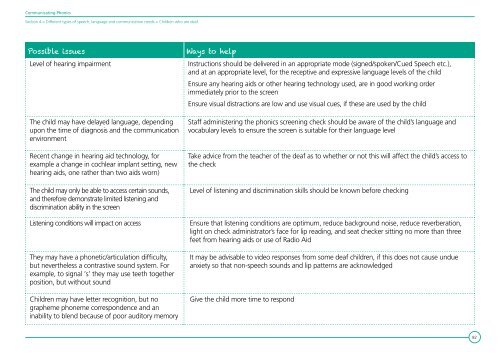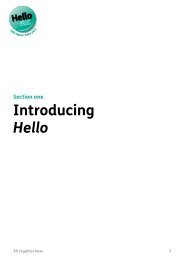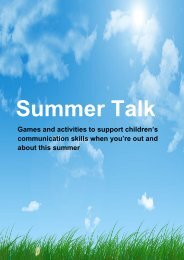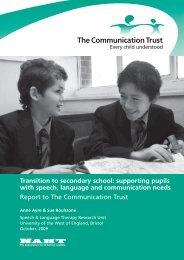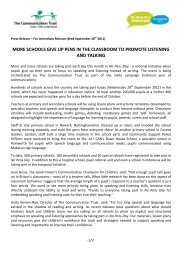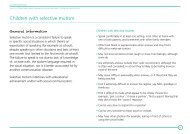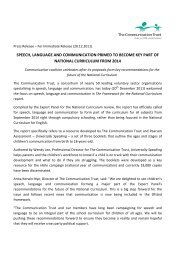<strong>Communicating</strong> <strong>Phonics</strong>Section 4 > Different types of speech, language and communication needs > Children who are deafPossible issuesLevel of hearing impairment<strong>The</strong> child may have delayed language, dependingupon the time of diagnosis and the communicationenvironmentRecent change in hearing aid technology, forexample a change in cochlear implant setting, newhearing aids, one rather than two aids worn)<strong>The</strong> child may only be able to access certain sounds,and therefore demonstrate limited listening anddiscrimination ability in the screenListening conditions will impact on access<strong>The</strong>y may have a phonetic/articulation difficulty,but nevertheless a contrastive sound system. Forexample, to signal ‘s’ they may use teeth togetherposition, but without soundChildren may have letter recognition, but nographeme phoneme correspondence and aninability to blend because of poor auditory memoryWays to helpInstructions should be delivered in an appropriate mode (signed/spoken/Cued Speech etc.),and at an appropriate level, for the receptive and expressive language levels of the childEnsure any hearing aids or other hearing technology used, are in good working orderimmediately prior to the screenEnsure visual distractions are low and use visual cues, if these are used by the childStaff administering the phonics screening check should be aware of the child’s language andvocabulary levels to ensure the screen is suitable for their language levelTake advice from the teacher of the deaf as to whether or not this will affect the child’s access tothe checkLevel of listening and discrimination skills should be known before checkingEnsure that listening conditions are optimum, reduce background noise, reduce reverberation,light on check administrator’s face for lip reading, and seat checker sitting no more than threefeet from hearing aids or use of Radio AidIt may be advisable to video responses from some deaf children, if this does not cause undueanxiety so that non-speech sounds and lip patterns are acknowledgedGive the child more time to respond82
<strong>Communicating</strong> <strong>Phonics</strong>Section 4 > Different types of speech, language and communication needs > Children who are deafTeachers teaching phonics to children known to be deaf orto have hearing impairment should consider the following, indiscussion with parents and with the Teacher of the Deaf:• Can we introduce a visual system from entry into thereception class, or is a universal visual system, such as Jolly<strong>Phonics</strong>, already in use?• Can a phonological awareness programme be introducedwith phonics?• Deaf children learning to read may benefit from wider oradditional approaches than just synthetic phonics, such asprogrammes like THRASS, which incorporates a whole wordapproach• Some deaf children acquire phonics at a delayed rate, whileothers may require specialist support/individualised programs;therefore programs should be flexible• Has the school received training regarding the deaf child’sability to listen and discriminate?• Does the school have a multi-sensory approach, withresources, appropriate for deaf students?<strong>The</strong> outcome of the checkWith improved neonatal screening for deafness and much improvedhearing aid technology, more deaf children are accessing spokenlanguage, given the appropriate strategies and therefore should beaccessing phonics. Where teachers have queries about individualchildren they should contact their Teacher of the Deaf.Some deaf children will attempt the task, but due to poor speechand a reduced sound system, resulting from reduced auditorydiscrimination skills, they may make errors. It may be difficult to judgeif children don’t know the phoneme associated with the grapheme orjust can’t produce it. <strong>The</strong> following are possible outcomes:• Depending on hearing loss some sounds will be harder to hearthan others• Some sounds, although they may be hard to hear, are veryvisible on the speaker’s lips, so certain phoneme/graphemecorrespondences are easier• <strong>The</strong>re are groups of sounds that are visually similar ‘f/v’, ‘p/b/m’,‘th/the’, ‘t/d/n’, ‘ch/sh’, etc and these may be confused; words thatsound different can look the same on the speaker’s lips such as‘pan/man’,‘cap/cab’, ‘fan/van’. <strong>The</strong>refore these constitute typicalerrors for children with hearing impairments• Common errors include voicing of consonants ‘f’ to ‘v’ and ‘p’ to‘b’ etc; lack of friction for some sounds, for example ‘f’ to ‘p’ and‘s’ to ‘t’; missing out sounds like ‘f’, ‘v’ ‘s’ and ‘sh’, as they are lessaudible; omitting unstressed soundsGuidance from a speech and language therapist or Teacher of theDeaf will help to identify if the child’s response is likely to be anaccurate reflection of their phonic skills.83


